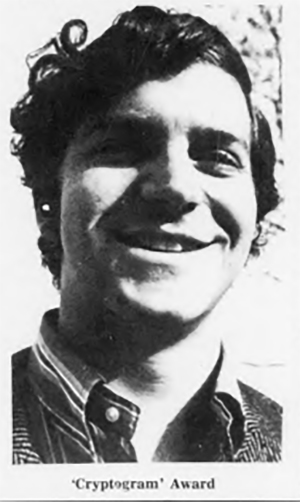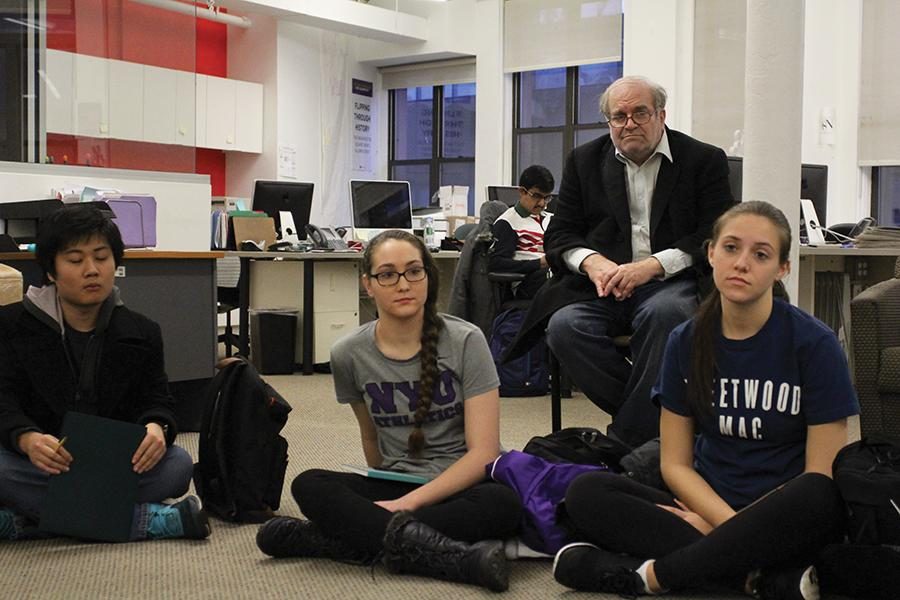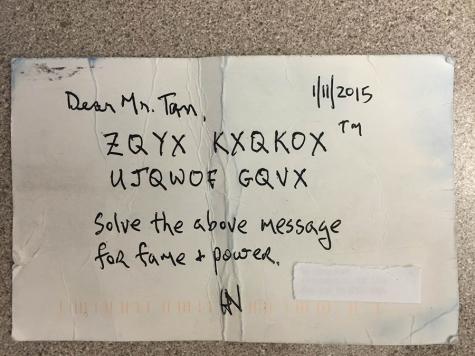The Curious Case of Henry E. Nass
Henry Nass sitting in on a pitch meeting at the WSN office on Feb 8.
February 17, 2015
I’m going to be honest: working at a student newspaper can be unbearably boring. The first thing you notice when you spend all your time glued to a computer screen is that the days start to melt together, which makes anything different or unusual a welcome distraction. It was almost inevitable, then, that when a small old man walked into our offices at 838 Broadway on Sunday, Feb 1. asking where to go for the pitch meeting, most of our staff suddenly started paying attention.
When the meeting started, the mysterious man with the thinning gray comb-over introduced himself as Henry E. Nass. Beyond that, he didn’t speak much. He didn’t take a pitch and he left without incident. It was certainly weird, but not that weird.
The next day, our managing editor Thomas Devlin was passing by the mailboxes when he noticed a postcard sent to Jonathan Tan, a former editor-at-large.
On the back of the card, there was a cryptic message:
Below the message, there was a piece of paper taped onto the card with the return address of a “Mr. Henry E. Nass.” OK, I thought, that’s weird.
For the next few hours, speculation about Nass and his mysterious message derailed our regular Monday production. Popular theories included that he was an avant-garde artist, genius puzzle master or just a garden-variety kook. No matter what people thought of him, however, none of us could shake the feeling that something about him was impossibly fascinating. Nass had withheld just enough information to leave a room full of student journalists dying to know more.
Through some very deep digging, we managed to piece together some of Nass’ background. He was in his mid-60s, grew up in upstate New York, graduated from the University of Pennsylvania in 1971 and had recently retired.
Among the tidbits we found about Nass — his founding of a Sudoku institute, an op-ed he wrote about the mail, a speech he had given at Columbia — what stood out the most was a phrase Nass had copyrighted in 1971: “Cynic’s crypt: round one.”
After a few hours of scouring the Internet, we learned the phrase was the name Nass had given to a puzzle he made for UPenn’s student newspaper, the Daily Pennsylvanian, in February 1971. It promised “Solutions to follow,” but our search turned up nothing but another cipher from April 1971, marked with the header “Right here, Diogenes!”
The first newspaper cipher was easy: “The eagle never lost so much as when he submitted to learn of the crow. —William Blake.” The second one stumped us completely, and by Wednesday night, we had only worked out a tentative, incomplete solution for the postcard cipher: “More People Should [Blank].” Joke? Toke? Note? Without a hint or context, it was hard to guess what it meant with any certainty.
We spent most of the week coming up with questions about Nass and spinning huge tales about his plans and the significance of his puzzles.
“I can’t help but feel like he’s the crow and we’re the eagle,” Devlin said. “We’ve spent so much time worrying about him and I think that’s what he wants.”
He made a good point.
“But he’s so nerdy and into puzzles,” our copy chief Maddie Pazzani said. “That’s great.”
She made a better point. Of all our questions, however, the most pressing one was whether or not Nass would show up at next week’s pitch meeting. Some people thought there was no way he would make himself known again — it would be tipping his hat too much. Others, like senior editor Francisco Navas, were so certain of his return that they wanted to put the security guard on notice for “a small, balding man who may or may not be the Zodiac killer.”
No matter how certain any of us were, everyone was speechless when, at 4:55 p.m. on Feb. 8, Nass ambled into our newsroom and took a seat. Our editor-in-chief Valentina Bojanini and I gave each other a look of disbelief and then tried to calm our nerves as we went to confront the man we had dubbed our “Staff White Whale.”
“My name is Valentina, I’m the editor-in-chief,” she said. “What are you here for?”
“I was really just trying to get a sense of a university newspaper, because there may be something that comes up later in the year that I might be interested in getting a story about,” Nass said. “About political candidacy.”
We talked in circles until Bojanini asked for his name, as if she hadn’t typed it into her search bar a million times, and slyly added, “Did you happen to send one of our editors-at-large a postcard?”
“Yes,” Nass said. “The message was just —” Before he could get another word out, I figured out the solution.
“More People Should Vote,” I said.
I quickly explained that I had a lot of questions and would like to interview him. He agreed, and 15 minutes later Bojanini and I set up in a quiet corner of the office and started asking Nass about his intentions. He got to the point almost immediately.
“I am planning to run for Congress, U.S. Congress, from the 10th Congressional District,” Nass said. “My plan is to run under a phrase that nobody could have any doubt as to the meaning of, and that is ‘More People Should Vote.’”
Bewildered, Bojanini and I could only manage an “Oh, OK,” between us. Nass continued, expanding on his proposed platform.
“[I] support very much a lot more people voting,” Nass said. “I have to tell you for the last election for Congress in 2014, with 720,000 people in this district, there were only 100,000 people who voted.”

As Nass, a registered Republican, expressed his concern over the state of voter turnout, he gave the impression that he genuinely cared about the issue. While his soft-spokenness may not have made him the most charismatic politician — and the ciphers certainly did not make the most conventional one — he seemed sincerely passionate about the city he had lived in for most of his adult life. While securing voter participation was a fairly mainstream political objective, his other campaign goal was a bit more indicative of his eccentricity.
“The second point is a little bit of a personal interest of mine and has been for a long time,” Nass said. “I think we need a new fundamental transportation mode. Now we have four: air, water, roads and rail. What is left is something that’s already proven itself historically, on one scale, and I think needs to be scaled up — and that is a tube system.”
For 10 minutes, Nass gave us his elevator, or rather tube, pitch. The whole idea was impossibly idealistic and almost like something out of science fiction, but Nass had come prepared to convert even the hardest skeptics.
He cited supporters of this so-called fifth mode including Elon Musk, who recently proposed Hyperloop, a 500 mph commuter tube-train between Los Angeles and San Francisco. From his bag, Nass produced a New York Times article on Chinese maglev tubes and told us about the 26-mile mail-tube system New York City used to have, adding that he would scale up these tubes for freight and then move on to passenger tubes.
After explaining his platform, Nass delved into his strategy. He explained that he was “a follower of an ancient book known as ‘The Art of War,’” and has been quietly preparing for his campaign. In the 2014 elections, Nass ran as a write-in candidate as a dry run for his election.
“There’s a big space on the ballot for people who want to get in the game without a lot of the hassle,” Nass said. “I can try it this way so that when I open my campaign, I am already on the record with votes — a proven vote-getter. And the fact is I ended up with 10 votes.”
He added that he had only spent $20 on fliers to get those votes, and said, “I got the most [votes] — except for the dead guy.” The dead guy he was referring to is Avigdor Miller, a well-respected Brooklyn rabbi who died in 2001 but still managed 13 write-ins.
When I asked him how the mysterious postcards he’d sent to us and several other student newspapers fit into his campaign, he looked at me as though the answer was immediately obvious.
“It fits in, in a sense, serendipitously,” Nass said. “Because if nothing came of it, it’s 34 cents. If I can at some point leverage off it, then I will.”
I had to admit, his unorthodox approach did get most of our office obsessed — he definitely had leverage.
Shortly after the interview ended, I reached out to Jill Castellano, the editor-in-chief of the Daily Pennsylvanian, who said their postcard also generated a minor newsroom commotion. And while that might mean Nass appeals only to student journalists and that he might not be able to translate his unusual platform into more than 10 votes, he seems willing to take the risk.
“I didn’t say, ‘Did you get my postcard?’” Nass said. “You asked, ‘Did you send me a postcard?’ That’s kind of the role chance plays in all this.”
Correction: Oct. 10, 2017
A previous version of this article stated that Avigdor Miller received 41 write-in votes, however, new information made available to WSN revealed that the deceased rabbi instead received 13 write-ins.
A version of this article appeared in the Tuesday, Feb. 17 print edition. Email John Ambrosio at [email protected].






























































































































































